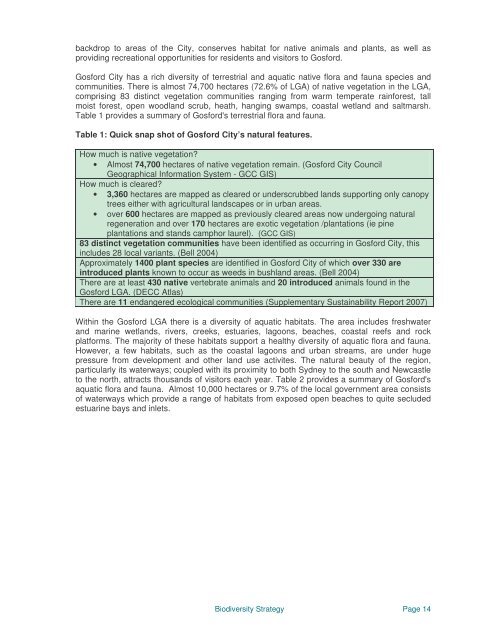Biodiversity Strategy - Gosford City Council - NSW Government
Biodiversity Strategy - Gosford City Council - NSW Government
Biodiversity Strategy - Gosford City Council - NSW Government
Create successful ePaper yourself
Turn your PDF publications into a flip-book with our unique Google optimized e-Paper software.
ackdrop to areas of the <strong>City</strong>, conserves habitat for native animals and plants, as well as<br />
providing recreational opportunities for residents and visitors to <strong>Gosford</strong>.<br />
<strong>Gosford</strong> <strong>City</strong> has a rich diversity of terrestrial and aquatic native flora and fauna species and<br />
communities. There is almost 74,700 hectares (72.6% of LGA) of native vegetation in the LGA,<br />
comprising 83 distinct vegetation communities ranging from warm temperate rainforest, tall<br />
moist forest, open woodland scrub, heath, hanging swamps, coastal wetland and saltmarsh.<br />
Table 1 provides a summary of <strong>Gosford</strong>'s terrestrial flora and fauna.<br />
Table 1: Quick snap shot of <strong>Gosford</strong> <strong>City</strong>’s natural features.<br />
How much is native vegetation?<br />
• Almost 74,700 hectares of native vegetation remain. (<strong>Gosford</strong> <strong>City</strong> <strong>Council</strong><br />
Geographical Information System - GCC GIS)<br />
How much is cleared?<br />
• 3,360 hectares are mapped as cleared or underscrubbed lands supporting only canopy<br />
trees either with agricultural landscapes or in urban areas.<br />
• over 600 hectares are mapped as previously cleared areas now undergoing natural<br />
regeneration and over 170 hectares are exotic vegetation /plantations (ie pine<br />
plantations and stands camphor laurel). (GCC GIS)<br />
83 distinct vegetation communities have been identified as occurring in <strong>Gosford</strong> <strong>City</strong>, this<br />
includes 28 local variants. (Bell 2004)<br />
Approximately 1400 plant species are identified in <strong>Gosford</strong> <strong>City</strong> of which over 330 are<br />
introduced plants known to occur as weeds in bushland areas. (Bell 2004)<br />
There are at least 430 native vertebrate animals and 20 introduced animals found in the<br />
<strong>Gosford</strong> LGA. (DECC Atlas)<br />
There are 11 endangered ecological communities (Supplementary Sustainability Report 2007)<br />
Within the <strong>Gosford</strong> LGA there is a diversity of aquatic habitats. The area includes freshwater<br />
and marine wetlands, rivers, creeks, estuaries, lagoons, beaches, coastal reefs and rock<br />
platforms. The majority of these habitats support a healthy diversity of aquatic flora and fauna.<br />
However, a few habitats, such as the coastal lagoons and urban streams, are under huge<br />
pressure from development and other land use activites. The natural beauty of the region,<br />
particularly its waterways; coupled with its proximity to both Sydney to the south and Newcastle<br />
to the north, attracts thousands of visitors each year. Table 2 provides a summary of <strong>Gosford</strong>'s<br />
aquatic flora and fauna. Almost 10,000 hectares or 9.7% of the local government area consists<br />
of waterways which provide a range of habitats from exposed open beaches to quite secluded<br />
estuarine bays and inlets.<br />
<strong>Biodiversity</strong> <strong>Strategy</strong> Page 14
















